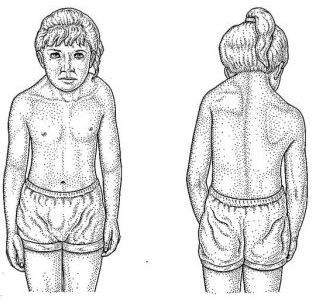(Congenital elevation of the scapula)
Malformation of the scapular.: the scapula is elevated and the malposition may restrict the movement of the upper limb. The default position of the scapula is due to anatomical changes of the scapula as well as muscle abnormalities and vertebral local (fusion, cervical rib), making it a regional malformation. The homolateral clavicle is also distorted.
This deformation can be isolated but is generally associated with other anomalies:
- malformation of the vertebrae: Klippel-Feil syndrome, for example (see this term)
- spina bifida
- kyphoscoliosis
An omovertebral bar (fibrous, cartilaginous or bony bridge between the scapula and the cervical spine) is often present.

Anesthetic implications:
risk of difficult intubation by diminution of mobility; check for absence of anomalies of the cervical vertebrae and of periaxial anomalies (tethered spinal cord, spina bifida occulta) before performing a perimedullar block.
Some surgeons use neurostimulation during corrective surgery: check before curarizing the patient.
References :
- Stevens E, Williams B, Kock N, Kitching M, Simpson MP.
Cord injury after spinal anaesthesia in a patient with previously undiagnosed Klippel-Feil syndrome.
Anaesthesia Reports 2019; 7:7-10
- Okada M, Tanaka N, Suzuka T, Kadoya Y, Saisu T, Kawaguchi M.
Anesthetic management of scapular Y‑osteotomy using a combination of suprascapular nerve block and erector spinae plane block for Sprengel deformity associated with Klippel‑Feil syndrome: a case report.
JA Clinical Reports 2023 ; 9:55 doi.org/10.1186/s40981-023-00647-3
Updated: July 2024